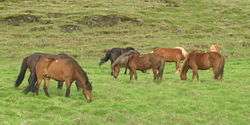Horse transports in the Middle Ages
Horse transports in the Middle Ages were boats used for effective means of transporting horses over long distances, whether for war or general transport. They can be found from the Early Middle Ages, in Celtic, Germanic and Mediterranean traditions.
Military shipment of horses
The Mediterranean World

The Romans had developed efficient methods of sea transport for horses, which were improved by the Arabic nations in the Early Middle Ages; these transports became common in Europe from the tenth century.[1] Horse transports could be powered by oars or, sometimes, by sail.
The oared tarida was able to be loaded and unloaded directly on a beach, using doors as loading ramps.[2] In 1174 an Italo-Norman force attacked Alexandria with 1,500 horses transported on 36 tarides.[3] Detailed specifications for thirteenth century tarides exist, showing they could carry 20-30 horses. In Angevin tarides, horses were stalled in threes, supported by canvas slings. Genoese tarides in 1246 carried 150 water butts containing 39,750 litres in total.[4]
Sailing transports, known as usciere in Italian (French huissiers; Latin usserii), were also built. These had two decks and could carry up to 100 horses. The horses were loaded through openings in the hull, which were then sealed for the voyage. Venetian usciere built for Louis IX in 1268 were 25.76m long, had a beam of 6.1m, had two decks and two masts.[5]
Northern Europe

Records of cavalry transportation abound throughout the period, reflecting the changes in warfare. For example, the Scandinavians had adapted the horse-transport technology by the 12th century as part of their move away from the traditional Viking infantry.[6] The first illustration displaying such horse-transport in western Europe can be found in the Bayeux Tapestry's depiction of the Norman conquest of England.[7] This particular military venture required the transfer of over 2,000 horses from Normandy.[8]
The small size of many transport vessels available and the need to carry fodder and water on all but the shortest journeys restricted the number of horses that could be carried. Records from the 13th century show a range from 8 to 20 horses.[9] In 1303 ships transporting horses between Scotland and Ireland carried between 10 and 32 animals.[10]
Adapting a ship for horse transportation required the installation of stalls of wood or hurdles. Detailed records of the fitting of an English fleet of 1340 show the creation of 418 hurdles, 413 iron rings and staples, canvas mangers and the creation of four gangways for loading 30 ft long by 5 wide. Similar records from 1338 show 47 ships were equipped with 134 tuns to carry water for horses.[11] Whether English vessels used canvas slings to support the horses like contemporary Mediterranean practice is uncertain. Military historian Michael Prestwich speculates they did [12] and he is supported by naval historian Ian Friel, who believes that the references to canvas mangers referred to above should actually be translated as canvas slings.[13]
Shipping horses for trade
The development and building of horse transports for use in war meant it remained easy to transfer horses for breeding and purchase during peacetime. After William of Normandy's successful conquest of England, he continued to bring horses across from Normandy for breeding purposes, improving the bloodstock of the English horses.[8] By the time of the Hundred Years' War, the English government banned the export of horses in times of crisis.[14]

Footnotes
- ↑ Nicolle (1999) p 271
- ↑ Nicolle (1999) pp 271-4
- ↑ Nicolle (1999), p 274
- ↑ Prior (2004), pp115-6
- ↑ Scandurro (1972), pp. 213-4
- ↑ Nicolle (1999) p
- ↑ Wilson, p 227
- 1 2 3 Hyland, p 99
- ↑ Rodger (2004), p.119
- ↑ Prestwich, p 271
- ↑ Hewitt (2004), pp. 180-181
- ↑ Prestwich, p 270
- ↑ Friel (1995), p.136
- ↑ Nicolle (2000), p 22
References
- Bennett, Matthew; Bradbury, Jim; DeVries, Kelly; Dickie, Iain; Jestice, Phyllis G. (2005) Fighting Techniques of the Medieval World: AD 500-AD 1500, London: Amber Books ISBN 1-86227-299-9
- Friel, Ian (1995). The Good Ship: Ships, Shipbuilding and Technology in England 1200-1520. London: British Museum. ISBN 0-7141-0574-0.
- Hewitt, H.J. (2004) [1966]. The Organisation of War under Edward III. Barnsley: Pen & Sword. ISBN 1-84415-231-6.
- Hyland, Ann (1994) The Medieval Warhorse: From Byzantium to the Crusades, London: Grange Books, ISBN 1-85627-990-1
- Nicolle, David (1999) Medieval Warfare Source Book: Warfare in Western Christendom, UK: Brockhampton Press. ISBN 1-86019-889-9
- Nicolle, David (2000) Crécy 1346: Triumph of the longbow, Osprey Publishing Paperback ISBN 978-1-85532-966-9
- Prestwich, Michael (1996) Armies and Warfare in the Middle Ages: The English Experience, New Haven: Yale University Press ISBN 0-300-07663-0
- Pryor, John H. (2004) [1995]. "From Dromon to Galea: Mediterranean Bireme Galleys AD 500-1300". In Gardiner, Robert. The Age of the Galley. Conway's History of the Ship. London: Conway Maritime Press. pp. 101–116. ISBN 0-85177-955-7.
- Rodger, N.A.M. (2004). The Safeguard of the Sea. London: Penguin.
- Scandurro, Enrico (1972). "The Maritime Republics : Medieval and Renaissance ships in Italy". In Bass, George F. A History of Seafaring. London: Thames & Hudson. pp. 206–224.
- Wilson, David M. (1985) The Bayeux Tapestry, London: Thames and Hudson